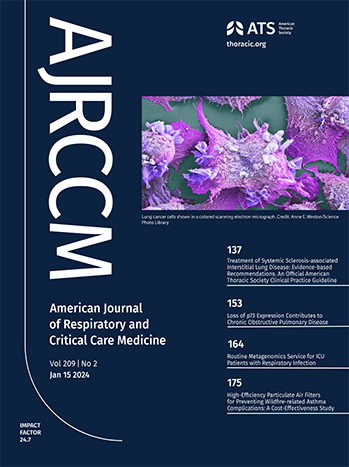ARDS Molecular Phenotypes Have Distinct Lower Respiratory Tract Transcriptomes.
IF 19.4
1区 医学
Q1 CRITICAL CARE MEDICINE
American journal of respiratory and critical care medicine
Pub Date : 2025-09-25
DOI:10.1164/rccm.202407-1454oc
引用次数: 0
Abstract
RATIONALE Two molecular phenotypes of the acute respiratory distress syndrome (ARDS) with divergent clinical trajectories and responses to therapy have been identified. Classification as "hyperinflammatory" or "hypoinflammatory" depends on plasma biomarker profiling. Limited data are available about the differences in the pulmonary biology of the molecular phenotypes. OBJECTIVES To identify differences in the pulmonary biology of ARDS molecular phenotypes. MEASUREMENTS We compared tracheal aspirate gene expression between hyperinflammatory and hypoinflammatory phenotypes in bulk RNASeq from COVID and non-COVID ARDS, and single cell RNASeq from non-COVID ARDS. In a subset of subjects, we also compared plasma proteomic data. MAIN RESULTS In bulk RNASeq analyses, 1157 genes were differentially expressed (FDR < 0.1) between phenotypes in non-COVID ARDS, and 85 genes were differentially expressed between phenotypes in COVID ARDS. 18 genes were reproducibly differentially expressed between phenotypes in both cohorts, including greater expression of IL32, HSPA8, and PPP3CC in hyperinflammatory ARDS. Gene set enrichment analysis identified greater expression of granulopoiesis, T cell and interferon signaling, and integrated stress response pathways in hyperinflammatory ARDS. Network analysis of scRNASeq in a third group of patients identified greater T cell signaling to other immune cells in hyperinflammatory ARDS. CONCLUSIONS Hyperinflammatory and hypoinflammatory ARDS molecular phenotypes have distinct air space biology. Hyperinflammatory ARDS is characterized by an increased interferon-stimulated gene expression and T cell activation in the lungs. This article is open access and distributed under the terms of the Creative Commons Attribution Non-Commercial No Derivatives License 4.0 (http://creativecommons.org/licenses/by-nc-nd/4.0/).ARDS分子表型具有不同的下呼吸道转录组。
急性呼吸窘迫综合征(ARDS)的两种分子表型具有不同的临床轨迹和对治疗的反应已经确定。“高炎症”或“低炎症”的分类取决于血浆生物标志物谱。关于分子表型的肺生物学差异的数据有限。目的探讨急性呼吸窘迫综合征(ARDS)分子表型的肺生物学差异。我们比较了来自COVID和非COVID - ARDS的大量RNASeq和来自非COVID - ARDS的单细胞RNASeq的气管吸入基因在高炎症和低炎症表型中的表达。在一部分受试者中,我们还比较了血浆蛋白质组学数据。结果大量RNASeq分析显示,非COVID - ARDS患者表型间差异表达基因有1157个(FDR < 0.1),而COVID - ARDS患者表型间差异表达基因有85个。在两个队列中,18个基因在表型之间存在可重复性差异表达,包括高炎症性ARDS中IL32、HSPA8和PPP3CC的更高表达。基因集富集分析发现,在高炎症性ARDS中,颗粒生成、T细胞和干扰素信号以及综合应激反应途径的表达更高。第三组患者的scRNASeq网络分析发现,在高炎症性ARDS患者中,T细胞向其他免疫细胞的信号传导更大。结论重度炎症性和轻度炎症性ARDS分子表型具有不同的空间生物学特征。急性呼吸窘迫综合征的特点是肺部干扰素刺激基因表达和T细胞活化增加。本文在知识共享署名非商业禁止衍生品许可4.0 (http://creativecommons.org/licenses/by-nc-nd/4.0/)的条款下开放获取和分发。
本文章由计算机程序翻译,如有差异,请以英文原文为准。
求助全文
约1分钟内获得全文
求助全文
来源期刊
CiteScore
27.30
自引率
4.50%
发文量
1313
审稿时长
3-6 weeks
期刊介绍:
The American Journal of Respiratory and Critical Care Medicine focuses on human biology and disease, as well as animal studies that contribute to the understanding of pathophysiology and treatment of diseases that affect the respiratory system and critically ill patients. Papers that are solely or predominantly based in cell and molecular biology are published in the companion journal, the American Journal of Respiratory Cell and Molecular Biology. The Journal also seeks to publish clinical trials and outstanding review articles on areas of interest in several forms. The State-of-the-Art review is a treatise usually covering a broad field that brings bench research to the bedside. Shorter reviews are published as Critical Care Perspectives or Pulmonary Perspectives. These are generally focused on a more limited area and advance a concerted opinion about care for a specific process. Concise Clinical Reviews provide an evidence-based synthesis of the literature pertaining to topics of fundamental importance to the practice of pulmonary, critical care, and sleep medicine. Images providing advances or unusual contributions to the field are published as Images in Pulmonary, Critical Care, Sleep Medicine and the Sciences.
A recent trend and future direction of the Journal has been to include debates of a topical nature on issues of importance in pulmonary and critical care medicine and to the membership of the American Thoracic Society. Other recent changes have included encompassing works from the field of critical care medicine and the extension of the editorial governing of journal policy to colleagues outside of the United States of America. The focus and direction of the Journal is to establish an international forum for state-of-the-art respiratory and critical care medicine.

 求助内容:
求助内容: 应助结果提醒方式:
应助结果提醒方式:


